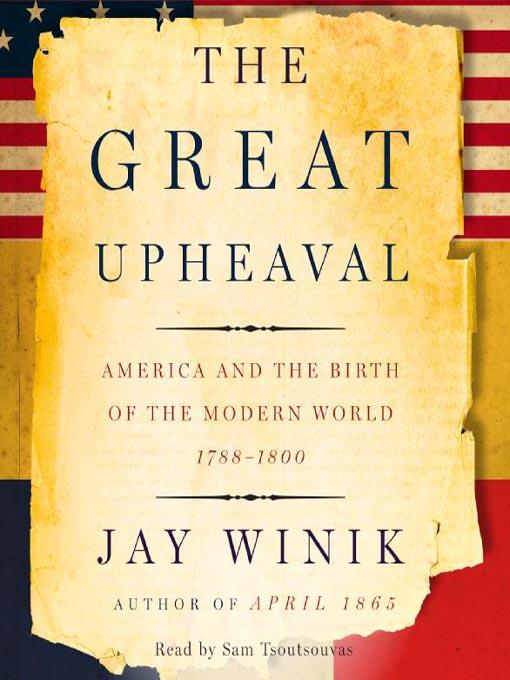
The Great Upheaval
America and the Birth of the Modern World 1788-1800
کتاب های مرتبط
- اطلاعات
- نقد و بررسی
- دیدگاه کاربران
نقد و بررسی

Jay Winik's stirring narrative is filled with high drama and strong verbs--it's a tale whose telling requires the steadiness of an accomplished narrator. Sam Tsoutsouvas's mellow, assured tone establishes the thread of a narrative that roams from the American frontier to the farthest reaches of the Russian Empire under Catherine the Great. The drama of those pivotal final years of the eighteenth century--which embraced the American Revolution and Constitution, the French Revolution, and the rise of Napoleon--is heightened by Winik's sense of the momentous, a word he himself frequently employs. Tsoutsouvas maintains the necessary pace and consistency to modulate the intensity (and frequent ferocity) of this narrative's many scenes of action. An excellent popular history, this is a perfect match of book and narrator. D.A.W. (c) AudioFile 2008, Portland, Maine

Starred review from July 23, 2007
The years 1788 to 1800 must be numbered among the most tumultuous in history, as bestselling author Winik (April 1865
) magnificently demonstrates in this aptly titled book. The nascent United States, tormented by three rebellions of its own, tottered as France descended into bloody terror and imperial Russia fought the Ottomans. Republicanism, liberalism, democracy, nationalism, as well as authoritarianism: all these potent ideologies, whose effects remain with us, sprouted from this fertile soil.
The emphasis on Russian and French affairs marks Winik as being in the forefront of a growing campaign to globalize America's national history: to view “the larger age” and frame the story as “one continuous, interlocking narrative” rather than to focus myopically on events in the United States. “The world then was far more interconnected than we realize,” Winik writes. “reat nations and leaders were acutely conscious of one another.”
In this version, Washington, Jefferson and Adams no longer receive exclusive star billing, but instead share the stage with such greats as the Empress Catherine, the doomed Louis XVI, Robespierre, Napoleon and Kosciuszko. If there is a criticism to be made of this approach, it is that Winik has greatly underplayed the importance of Britain in the struggle for global mastery and the quest for international order.
Buttressed by impeccable research, vividly narrated and deftly organized, this is popular history of the highest order and is sure to create a stir in the fall market. 16 pages of b&w photos, 3 maps.

Starred review from October 1, 2007
In this popular history of America, France, and Russia during the last decade of the 18th century, Winik (senior scholar, Sch. of Public Policy, Univ. of Maryland, College Park; "April 1865") truly brings the age alive. Each chapter addresses one of these countries (the Ottoman Empire also surely deserved its own chapters instead of containment within the Russian chapter) but always weaves in perspectives relating to the others. Throughout, Winik offers dramatic flair without sacrificing fact. Readers will quickly get absorbed in the drama of America's early republic, not simply in isolation but in relation to the horrible war between Russia and the Ottoman Empire. The darkest hours of the French Revolution are seen here in their effect upon Catherine the Great of Russia. Winik reminds us just how extraordinary it was that America's government changed peacefully: party politics (Republicans vs. Federalists) did not plunge the nation into a full-scale revolution with the kind of massacres that occurred in France. The author uses mainly secondary sources, so the book would not appeal to upper-level graduate students, but the bibliographic notes at the end will help readers learn more about each topic. Highly recommended for all public, high school, and undergraduate libraries. [See Prepub Alert, "LJ" 5/15/07.]Bryan Craig, MLS, Nellysford, VA
Copyright 2007 Library Journal, LLC Used with permission.

August 1, 2007
The great strengths of Winiks massive examination of this tumultuous period is his demonstration of how events in the U.S. and Europe were part of a process of cross-fertilization. The title dates are not arbitrary. In 1788, the U.S. began its operation under a new constitution; in 1800, after years of partisan divisions and social conflict, the Americans peacefully accepted the transfer of power from the Federalists to Jeffersons Democratic-Republicans. Between those years, the U.S. and Europe experienced turmoil, revolution, and wars that shaped the world for the next two centuries. American commitment to republican ideals influenced French revolutionaries; they, under the threat of foreign intervention, instituted a repressive regime that would presage twentieth-century totalitarianism. In Russia, the enlightened Catherine the Great was shocked by the violence in France and turned from liberalization to a strengthened autocracy. Her desire for expansion led to the destruction of the Polish state and war with the Muslim Turks, both of which had immense consequences in the twentieth century. An outstandingly wide-ranging account of this vital era in world history.(Reprinted with permission of Booklist, copyright 2007, American Library Association.)

























دیدگاه کاربران